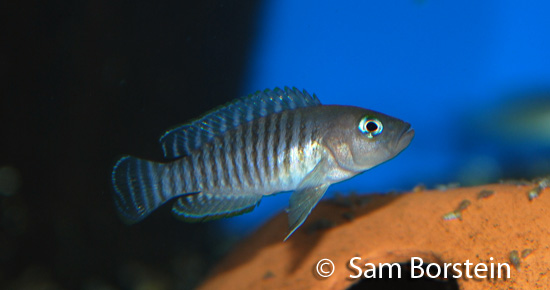'Lamprologus' multifasciatus
(Boulenger, 1906)
Multies
Synonyms: Neolamprologus multifasciatus

Above: 'Lamprologus' multifasciatus. Photo by Sam Borstein.
Etymology:
Genus- Lampas= Bright (Latin), lagos= hare (Greek)
Species- multi= many (Latin), fasciatus= stripes (Latin).
Intro:
'Lamprologus' multifasciatus is a tiny shell dweller from Lake Tanganyika. This fish is really neat. 'Lamprologus' multifasciatus gets its name from its stripes. Multifasciatus means "multiple stripes". This fish is a perfect fit for a tank on your desk at work as they require little space and display awesome behavior. They are a blast to watch.Distribution:
Multies live in empty shells on the sandy bottom of Lake Tanganyika.Size, Maturity, and Sexual Dimorphism:
Size: Males- 1.5 inches, Females- 1 inchMaturity: .5 inches
Sexual Dimorphism: Males are larger.
Care:
Multies are small, yet aggressive. They are fearless fish. They will do ok in a community tank, as long as they don't get eaten by larger fish. Multies will do fine in a small tank also. I kept six in a 3-gallon tank (although I highly recommend a larger tank). A 10 or 20 gallon will work great. Since they are a shell dweller there should be shells in the tank, but 1/2 inch PVC elbows work fine. These PVC elbows make it extremely easy to get the fish out. All you need to do is twist off the cap.I know people who put Multies in large tanks, like a 75, and the behavior is amazing as a couple of males will spread out their breeding territories.
Diet:
Multies need small food with lots of protein. I fed my adult Multies spectrum and baby brine shrimp. The babies are so small that if you ever want to get them to a sellable size you must feed baby brine shrimp. You will never see the babies otherwise, because they do not come out of the shell until they are half an inch long.Breeding:
Multies have a lot of neat breeding behaviors.Males will become very territorial around spawning time and allow females into their territory to spawn. The male will defend his harem against all other males, but will sometimes allow another female into the territory to spawn with. It's important to feed baby brine shrimp all the time to this fish. It's very hard to now when you have fry in the tank as they won't venture out of the shells until they are around 1/3-1/4 inch long. The fry are easy to raise otherwise. Females will also take food and carry it in their mouth back to the shell and crush up to feed it to their babies. This can be seen as a female will hed thrash into the shell and spit food into it.Conclusion:
This popular Tanganyikan is a great fish and easily my favorite Tanganyikan. They can be a bit pricey and are sometimes difficult to find, but you should give them a try. The perfect fish for an office tank.References:
- Konings, A. (1998) Tanganyikan cichlids in their natural habitat. Cichlid Press, El Paso, Texas, 272 pp.
